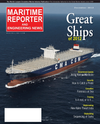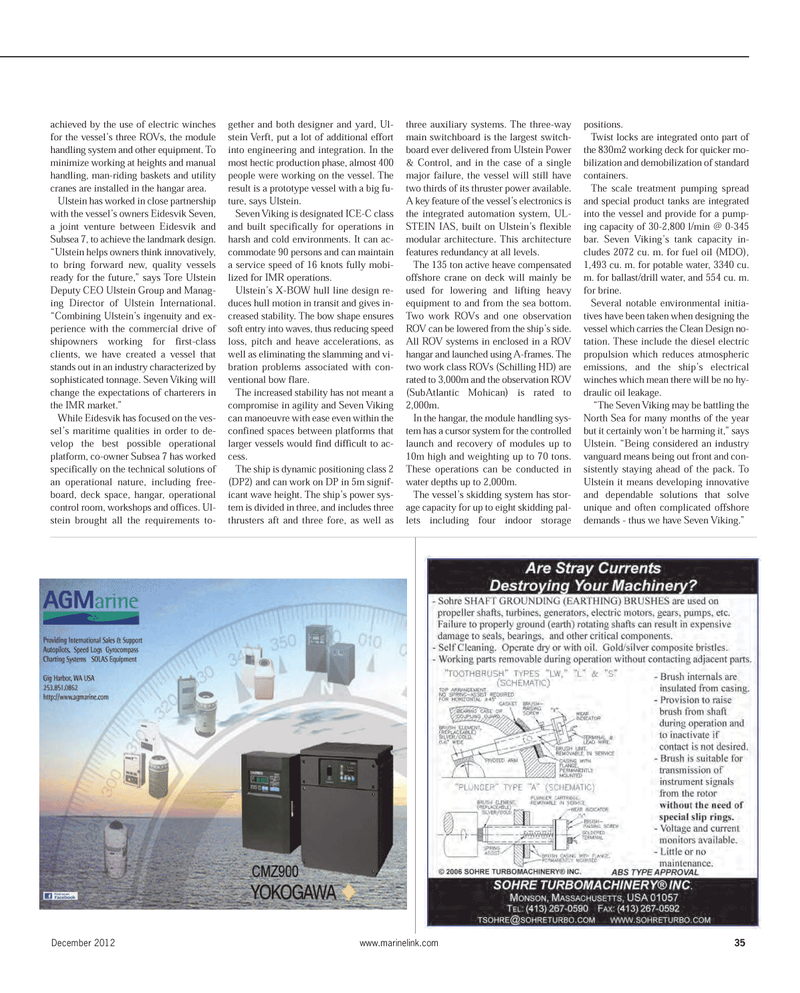
Page 35: of Maritime Reporter Magazine (December 2012)
Great Ships of 2012
Read this page in Pdf, Flash or Html5 edition of December 2012 Maritime Reporter Magazine
December 2012www.marinelink.com 35achieved by the use of electric winches for the vessel?s three ROVs, the module handling system and other equipment. To minimize working at heights and manual handling, man-riding baskets and utility cranes are installed in the hangar area. Ulstein has worked in close partnership with the vessel?s owners Eidesvik Seven, a joint venture between Eidesvik and Subsea 7, to achieve the landmark design. ?Ulstein helps owners think innovatively, to bring forward new, quality vessels ready for the future,? says Tore Ulstein Deputy CEO Ulstein Group and Manag-ing Director of Ulstein International.?Combining Ulstein?s ingenuity and ex- perience with the commercial drive of shipowners working for first-class clients, we have created a vessel that stands out in an industry characterized bysophisticated tonnage. Seven Viking will change the expectations of charterers in the IMR market.? While Eidesvik has focused on the ves- sel?s maritime qualities in order to de- velop the best possible operational platform, co-owner Subsea 7 has worked specifically on the technical solutions of an operational nature, including free-board, deck space, hangar, operational control room, workshops and offices. Ul- stein brought all the requirements to-gether and both designer and yard, Ul-stein Verft, put a lot of additional effort into engineering and integration. In the most hectic production phase, almost 400people were working on the vessel. The result is a prototype vessel with a big fu- ture, says Ulstein. Seven Viking is designated ICE-C class and built specifically for operations in harsh and cold environments. It can ac- commodate 90 persons and can maintaina service speed of 16 knots fully mobi-lized for IMR operations. Ulstein?s X-BOW hull line design re- duces hull motion in transit and gives in- creased stability. The bow shape ensures soft entry into waves, thus reducing speed loss, pitch and heave accelerations, as well as eliminating the slamming and vi-bration problems associated with con-ventional bow flare. The increased stability has not meant acompromise in agility and Seven Viking can manoeuvre with ease even within the confined spaces between platforms that larger vessels would find difficult to ac- cess. The ship is dynamic positioning class 2(DP2) and can work on DP in 5m signif- icant wave height. The ship?s power sys- tem is divided in three, and includes three thrusters aft and three fore, as well asthree auxiliary systems. The three-way main switchboard is the largest switch- board ever delivered from Ulstein Power & Control, and in the case of a singlemajor failure, the vessel will still have two thirds of its thruster power available. A key feature of the vessel?s electronics is the integrated automation system, UL- STEIN IAS, built on Ulstein?s flexible modular architecture. This architecture features redundancy at all levels. The 135 ton active heave compensated offshore crane on deck will mainly be used for lowering and lifting heavy equipment to and from the sea bottom.Two work ROVs and one observation ROV can be lowered from the ship?s side. All ROV systems in enclosed in a ROV hangar and launched using A-frames. The two work class ROVs (Schilling HD) are rated to 3,000m and the observation ROV (SubAtlantic Mohican) is rated to2,000m. In the hangar, the module handling sys- tem has a cursor system for the controlledlaunch and recovery of modules up to 10m high and weighting up to 70 tons.These operations can be conducted inwater depths up to 2,000m. The vessel?s skidding system has stor- age capacity for up to eight skidding pal-lets including four indoor storagepositions. Twist locks are integrated onto part of the 830m2 working deck for quicker mo- bilization and demobilization of standardcontainers. The scale treatment pumping spreadand special product tanks are integrated into the vessel and provide for a pump- ing capacity of 30-2,800 l/min @ 0-345bar. Seven Viking?s tank capacity in- cludes 2072 cu. m. for fuel oil (MDO),1,493 cu. m. for potable water, 3340 cu. m. for ballast/drill water, and 554 cu. m. for brine.Several notable environmental initia- tives have been taken when designing the vessel which carries the Clean Design no- tation. These include the diesel electric propulsion which reduces atmosphericemissions, and the ship?s electrical winches which mean there will be no hy- draulic oil leakage.?The Seven Viking may be battling the North Sea for many months of the year but it certainly won?t be harming it,? says Ulstein. ?Being considered an industryvanguard means being out front and con- sistently staying ahead of the pack. To Ulstein it means developing innovative and dependable solutions that solve unique and often complicated offshore demands - thus we have Seven Viking.? MR#12 (34-41):MR Template 12/4/2012 2:21 PM Page 35

 34
34

 36
36
